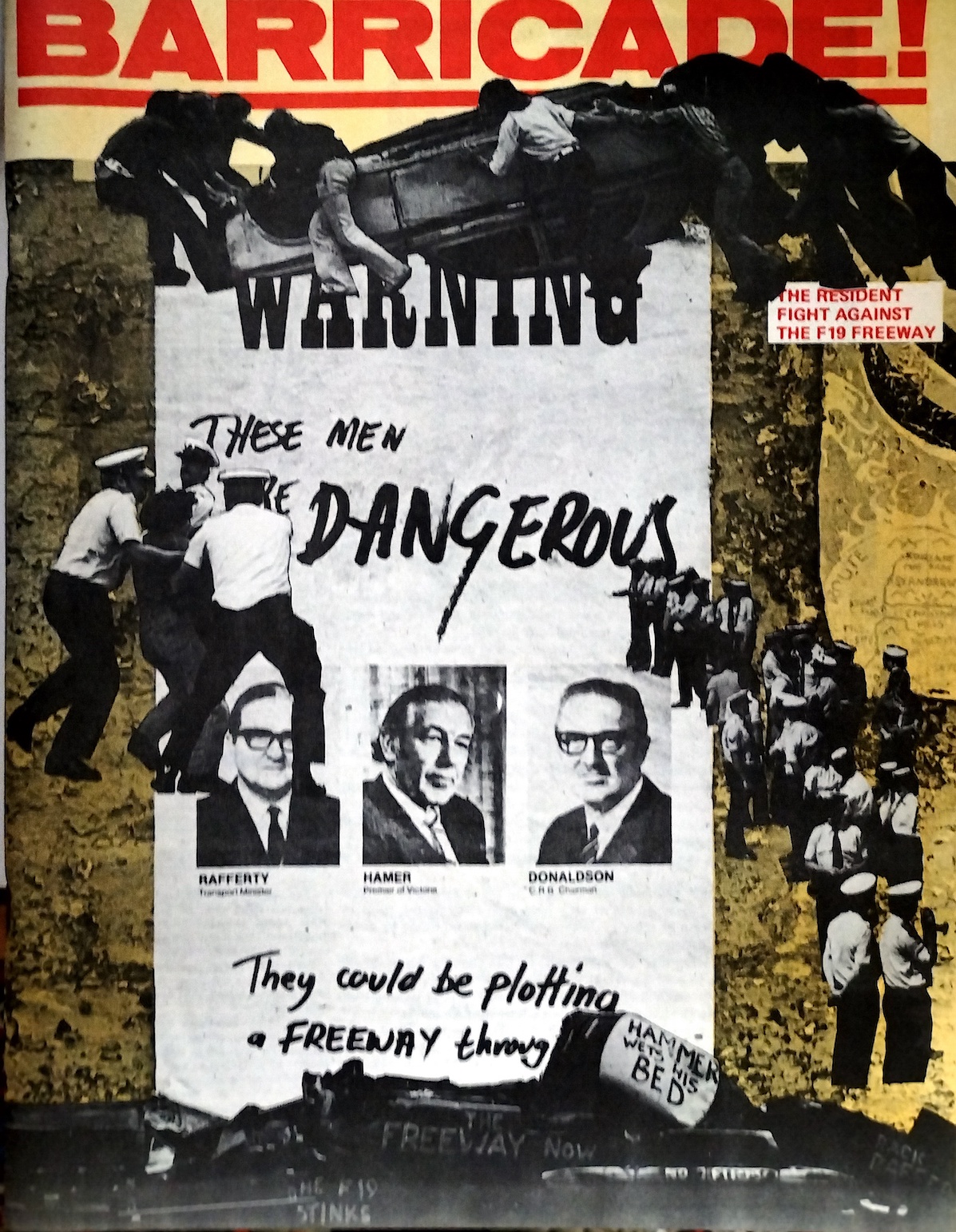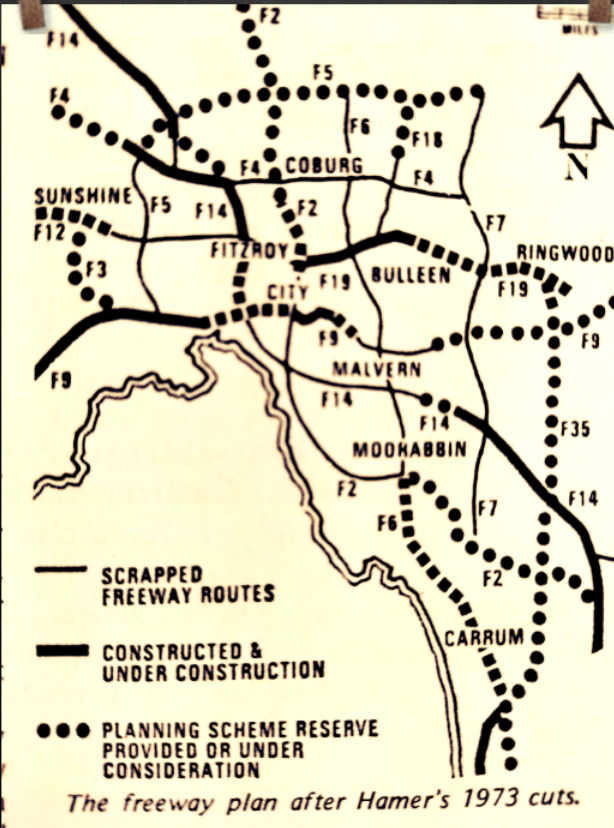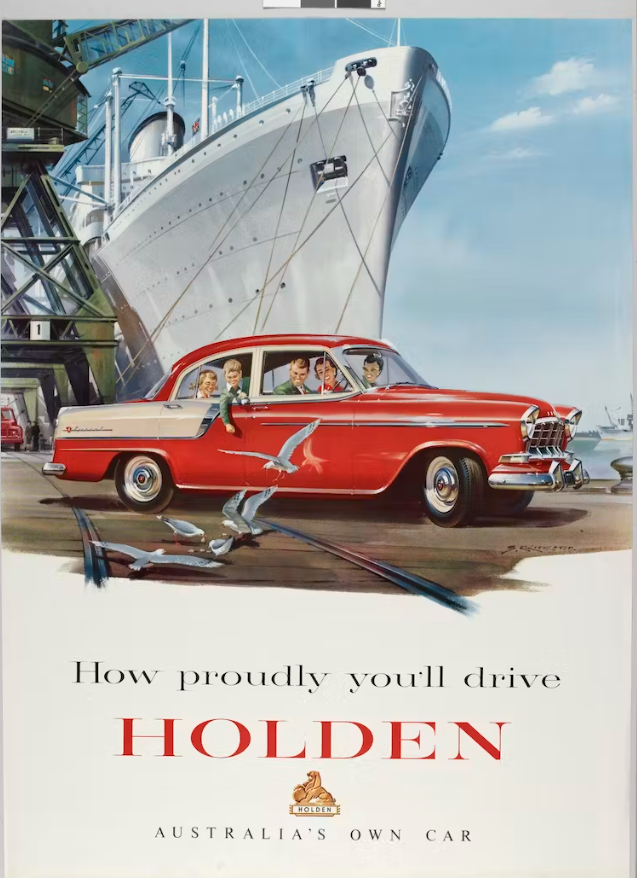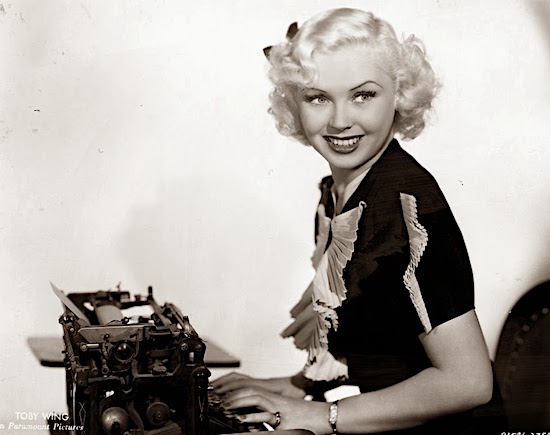barricade
Not the 1871 Commune, not Paris 1968 or Belfast in 1969 ... but suburban Fitzroy in 1977
Barricade! the resident fight against the F19 freeway
Anna hides in a shoebox somewhere, prancing in a photograph through flooded streets beneath a bright Chinese umbrella. I dig out all the albums and folders looking for the actual print, to no avail - but the real image is always in my mind. Never lost or missing, I still see her clearly even though half a century has slipped past.
Alexandra Parade Fitzroy, late 70s, inner city Naarm. Melbourne they called it then.
Round that corner right behind her, just down the median strip a bit, that's where we built the barricades.
This post tells a personal story of the anti freeway campaign waged by residents trying to stop the F19 freeway destroying their suburb. It references the booklet "Barricade"produced by residents involved in the campaign during November/December 1977...
We wandered across the little park to see what was going on, my housemates had heard it on the radio. The neighbouring kids tagged along, chattering. We skirted around the police line and joined the main crowd. Someone started talking about building a barricade to stop the Board of Works bulldozing the trees at the entry to the Parade. So we went back home to get my old Austin A40. The Greek neighbour helped push it through the side street to cheers and roars of approval. Anna steered with her sister and brother crammed in beside her. Never mind the extra load, they were only little kids.
With help we tipped it on its side, one of the first cars there ... another obstacle to progress.
Now as I write, I fish out my yellowing copy of Barricade! to recall the actual facts of those days and weeks. My mind sways from reminiscence to facts to politics and back to memoir. A few excerpts here and there, selective to be sure, but this history is almost forgotten today as the city morphs into a mini LA and society contemplates the end of the world as we know it.
We stopped the official opening of that freeway! Briefly, an ephemeral victory, not even pyrrhic. But still ...
People power was a thing in the seventies, something we all believed in. We'd already stopped conscription, helped the Vietnamese defeat the superpower, women were demanding fairness and equal pay, liberation even, not just burning their bras as the mainstream media pretended. Just a few years earlier workers had smashed the anti-union Penal Powers and freed the Communist leader Clarrie O'Shea from jail. Another Communist (of a different variety), Jack Mundey, helped residents save much of old Sydney from rapacious developers, while his rival Norm Gallagher did the same in Melbourne. Black bans, green bans ...
The students who had occupied university campuses in the sixties were now getting jobs and starting to question everything the old social order valued - hierarchy, patriarchy, destruction of the forests, so-called slum clearance ... everything.
The F19, now known as the Eastern Freeway or M3, had been planned since 1954 as a four-lane highway. In 1969 this was "upgraded" to a ten lane US-style freeway. In the back rooms the Australian Roads Federation lobbied and influenced policy and planning. Now called Roads Australia, back in 1977 they made RJ Hamer an Honorary Life Member - the Premier of Victoria and the man who pushed the demolition of the inner suburbs and the construction of both high-rise towers and wide American roadways.
The details, background and other information can be found in this PDF of the booklet Barricade! (Disclosure - we, tigerulze were active participants in the protests and author/publishers of this booklet)
Alexandra Parade was, at the time, a quiet leafy avenue with little traffic, linking Carlton in the west with Hoddle Street in the east. There was an underpass beneath the railway line and you could get right down to the Yarra. Across the river the trees of the national park stretched green as far as the eye could see. We went down there a few times, sometimes taking the local kids to Dights Falls.

The Milas kids had a Croatian father and an English mother. He was rarely home and when he was he beat her so she escaped periodically to a women's refuge, but always came back. I had no idea why he was violent because he acted normally to me. It had something to do with being Croatian rather than "Yugoslav." The kids spent a lot of time with us and sometimes we fed them. Anna told me how she tried to cook boiled eggs by soaking them in hot water from the tap, but it didn't work and they were raw and tasted disgusting. Once I went to check on them at night because I knew their mother was still at work in the clothing factory on the next corner, and there was a bucket of urine in their shared bedroom. They weren't allowed to use the outside toilet after dark.
This was our suburb, years before gentrification.
Our neighbours were Greeks, Italians, Yugoslavs, old Aussie workers, students. Teenagers played cricket on the concrete strip in the little park. Cats wailed at night. The knitting mill rattled all hours of every day except Sunday. A huge crowd rolled up at Victoria Park to watch Tommy Hafey coach the 'Pies before the 77 Grand Final. Fitzroy, Collingwood and Clifton Hill were distinct suburbs but seemed almost the same in temperament: small houses, narrow streets, bluestone lanes and a working class heritage.
Theo Sidiropolous, Mayor of Collingwood, had fought the Nazis back in Greece. A young resistance fighter, then migrant, tram conductor and now milk bar owner. Along with Fitzroy Mayor Bill Peterson he led the "official" resident opposition to the F19 plan. There were very few trendy hipsters in those days ... although quiet a few remnant hippies!
These local dignitaries, good people themselves, were joined by community activists and organisations as well as aspiring politicians in polite and legalistic argument and counter proposal. Run a rail line to East Doncaster ... restrict traffic on Alexandra Parade by diverting most of it onto Hoddle Street ... plant more trees ... double glaze the windows of houses on the Parade, and so on.
One such luminary was Brian Howe, a local Uniting Church minister, urban researcher and community activist. I had met him briefly a few years earlier in connection with caring for homeless men and back lane drinking. He was a good person who believed "the system" held the answers to social problems. A leader of Labor's Socialist Left, he ended up as Deputy Prime Minister of Australia under Hawke and Keating.
The leader and spokesman for the Campaign Against Freeways, a genuine citizen organisation, was Andrew Herrington who had been an anti-war activist and member of Friends of the Earth. He played a major role in the public meetings, delegations and negotiations, In later years he joined the ALP and served as a senior advisor to State and Federal governments. But in 1977 he was a long-haired-but-moderate-sort-of-radical.
Another supporter, then in State Parliament (in Opposition at that stage) was Barry Jones who had achieved a degree of fame as the TV quizz king on Pick-a-Box. He spoke at one rally rather eloquently about transport planning and matching social structures to the needs of the population. He held his hand up with fingers spread as he bemoaned the radial nature of Melbourne's rail network and the need for cross-city links. People worked all over the place and catching one train into the city and then another out to a distant suburb made little sense when you can hop in the car and drive across town.
But to this day neither state nor national governments have actually addressed any of these needs. The city spreads like a cancer and only the rich can now buy into the inner precincts. There are still no cross-city rail links, but there is a full network of toll roads and tunnels.
So the "official" opposition to the opening of the F19 - restricted to formal letters, public meetings and delegations - got nowhere and on October 9th 1977 three thousand local residents held a Community Day on the median strip at the end of the Parade, establishing a permanent vigil. The bulldozers sat just across Hoddle Street.
The two local Councils (Fitzroy and Collingwood) narrowed traffic on Alexandra Parade to one lane each way, but less than a week later the Government gazetted the Parade as a "State Highway" so removing this local street from Council jurisdiction. Democracy has many definitions.
On October 25th the Country Roads Board (CRB) started work at the Hoddle St end of the Parade, but we filled in the trench that evening. The very next day the "motorists' club" RACV called for the F19 to be extended right through Carlton to the Tullamarine Freeway. So much for delegations and negotiations and doing the right thing, the local resident opinion actually counted for nothing.
Residents responded with a permanent camp on the site. Then on November 7th 1977 the Victoria Police moved in to occupy the end of the Parade between Hoddle and Gold Streets, setting up caravans, toilets, fences and KFC rations! The immediate response was the barricade.
For the next month we had barricades, arrests, police patrols, all night vigils, campfires and an enormous outbreak of community spirit. The leadership of the protests slid from the Mayors Councillors and dignitaries to the mass of people out there on the street. It's tempting to equate this month with the Paris protests of '68 or the Prague Spring, the Commune or Eureka. But it wasn't really like that. Look at the photos - some here and some in this gallery - and look for a start at the police. Wearing short sleeved shirts and caps, not a shield or baton in sight. Look at us, youngsters, older residents, no weapons, laughing faces. This was a period of true community action when everyone, even the state, accepted a citizen's right to protest and take action ... as long as you played by the rules.
That's not to deny the potential for violence - nor the actuality. Some local business owners threatened the protestors, including the publican of the Tower Hotel and one Gerry Rothwell, proprietor of Clifton Automatics. The latter drove his prime mover straight into the barricade - "he knocked cars clean from the barricade right across Wellington Street ... then he stopped, jumped out of his cab carrying a .22 and ran towards "R" and just started hitting him ..." The Sun newspaper quoted Mr Rothwell as saying "I'd like to let loose with my fists on these bastards."
A curious thing was that Rothwell had already sold his business and in the interim took advantage of the blocked roadway to load and unload his trucks.
The night after this incident, primitive Molotov cocktails were hurled at the campers and the Council caravan where a child was sleeping. But what the press reported was the Police Commissioner Mick Miller talking about "urban terrorism" and a "freeway war" instigated by the protestors (page 3 The Herald Saturday 19th November.)

There's no denying it was a good time to be alive. We all felt the adrenaline pumping. And for a few weeks we really thought we were going to win. The police dismantled the barricade and we built a new one. The government promised to compromise and compensate. Meetings dragged on. Whenever the freeway construction looked like resuming thousands would rally to support the core who maintained the vigil around the clock. Singing colonial folk songs around the fires burning in 44 gallon drums.
For a brief moment in time, all those years ago, we actually believed we could stop the bulldozers, literally the machinery of the state. There's an anarchist phrase - "A different world is possible" - and as if in a dream we seemed to be on the edge of a different city, a different way of being. We did stop the bulldozers for a while, but not the state.
It was just a dream, a slim slender pale and undernourished fantasy.
Today? Ring roads, tunnels, gridlocks ... is life any better?
The sketch map shows the government's original plan for spaghetti-like freeways criss-crossing the city, often along the creeks that today are green corridors thanks in part to our resistance. It's pertinent that car ownership in Australia then was about 36 per 100 people, and ten years earlier only 25 per one hundred! The State Government's Metropolitan Transport Committee, set up in 1963, found that 37% of Melbourne households did not even own a car ... but instead of planning the city on that basis they engaged American consultants to draw up LA style freeway maps and then predict a tripling of car ownership over the next 20 years. That is, build the road network, ignore public transport as an alternative, and so encourage new car ownership.
Barricade! details the lobbying by the car industry and their allied businesses as they influenced public policy. For example, A.G. Gibbs was Managing Director of GM-H before he was appointed Chairman of Victorian Railways in 1973. He cited the Bland Report (1971-2) as his "bible." Bland recommended closure of many country branch lines, opening the railways to competition from road transport operators, especially for getting grain to the ports, introduction of contract road buses, and other "economically rational" measures. A substantial reduction in the number of railway employees resulted from these changes. It paved the way for later privatisation of all public transport.
A major outcome of the report was to replace the previous Rail Commissioners with a corporate Board, with Bill Gibbs as the first Chairman!
Nothing happens in a vacuum and Australia at that time was slipping away from the British Commonwealth (the Empire was already long gone) as we became totally enmeshed by American economics. Barricade! touches on the politics of this move. Half a century later we can see it all more clearly but at the time it was only us "radicals" "maoists" and "commos" that tried to articulate what was happening.
I myself was actually told to sit down by the crowd, at a midnight meeting just before the police moved in on the second barricade. I'd started to hold forth about "US imperialism" as I ramped up the rhetoric about saving our suburb. Sometimes it's hard to find the right turn of phrase.

The historical truth is that the US under President Eisenhower had passed the National Interstate and Defense Highways Act in 1956 which funded an accelerated program of highway construction, over-ruling states rights and diverting $25bn from other programs, including Defense, as well as introducing a federal gasoline tax. It's now a matter of public record that their two objectives - to network super highways between Army and Airforce bases as a defense strategy for the expected war with the Soviet Union, as well as to foster wider use (ie generate greater sales) of cars and trucks in the booming American economy - provided a blueprint to be exported across their international sphere of influence.
US car firms Ford and General Motors were already established here in the mid fifties but needed government intervention to minimize public transport (eg tearing up Sydney's tram network) and boost car ownership.
A major part of this transformation was to build a car oriented culture - as a sign of affluence, masculinity, technical sophistication and family satisfaction.
The F19 Freeway officially opened on December 7th 1977, with over one hundred police patrolling the entire route. The first car, escorted by police, was a Mercedes driven by "legendary" motor racing driver Bob Jane!
One week later the state government announce four new freeways. A week after that, just before Xmas, the CRB counted traffic in Carlton and noted a 15% increase even though many city workers were already taking holidays ... Since then the Eastern Freeway's been extended far to the east and linked to another running north-south. Today's transport map of the city would look a lot like the spaghetti diagram shown above.
A few years later my mum worked in the city selling washing machines. She drove in from the eastern suburbs along the very road we tried to stop. It used to take her an hour at peak but she amused herself with talk-back radio. Mostly middle aged white men telling her everything she wanted to hear.
Soon after the barricades our son was born and we moved to our own house further west, basically losing contact with old neighbours and friends as we built our own life. We never even got to reminisce about all that excitement, there are no books or TV series about those days. But surely someone somewhere in this brightly lit city looks at some of these images and recognises himself.
If I could actually sing it might be Another Fall of Rain, partly for the sentiment and partly for the memories of the camp fires at the vigil as we sang with no sense of irony a round of old Aussie folk songs celebrating our colonial heritage -
So its "Boss bring out the bottle" and we'll wet the final flock
For the shearers here may never meet again
Well some may meet next season and some not even then
And some they will just vanish like the rain
But I did bump into Anna once, beneath the Tullamarine Freeway overpass at Flemington Bridge. More irony. Wearing braces, she was heading for the old dental hospital and I'll swear she was wearing the same cardigan I'd last seen her in seven years before. We spoke awkwardly, she was probably fourteen or fifteen by then. I'm sad that I didn't really know what to say so we just waved each other goodbye.
Times change and most of our memories do too as everything fades away. Facts are facts, history did happen, but who can say what is real and true?
NOTES, LINKS and DOWNLOADS
Melbourne freeways were originally notated as F-19, F-7 etc. Later they became motorways - M3, M80 etc.
The CRB was the Country Roads Board, once charged with building and maintaining country roads and highways, and therefor the new freeways.
Download: Barricade! in PDF here
A selected photo gallery here
A collected history here at Yarra Campaign for Action on Transport
Also Julie New's version of the F19 struggle in Radical Tradition
And a review of the 1969 Melbourne Transport Plan, here in The Conversation
Some other historical background: "A History of the Barricade"


